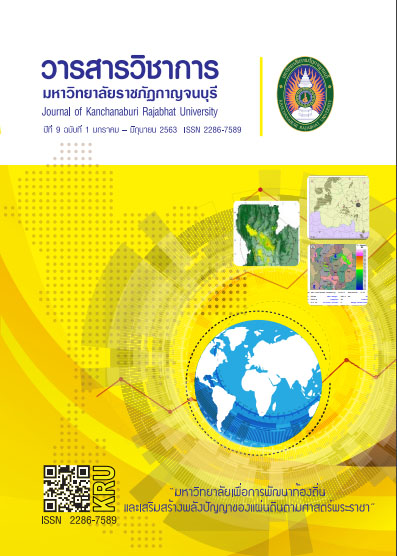RESULTS FROM EXERCISE PROGRAM WITH AEROBIC DANCE, EXERCISE BIKE AND TREADMILL TOWARDS BODY COMPOSITION IN OVER – WEIGHTED PEOPLE
Main Article Content
Abstract
The purposes of this research were to investigate and seek for the differences of the results from exercise program with aerobic dance, exercise bike and treadmill towards body composition in over-weighted people. The samples used in the research consisted of personnel and students from Institute of Physical Education Suphan Buri Campus by purposive selection with the set criteria for those who got overweight to find a body mass index (BMI). The thirty samples were selected and divided into three groups, each of which comprised ten people. Group 1 exercise program aerobic dance, group 2 exercise program bike and group 3 exercise program treadmill
The findings revealed as the following:
- Mean and standard deviation of body mass index and fat percentage before exercise, after the sixth week and after the twelfth week were found as follows. In Group 1, the over-weighted people’s body mass index and fat percentage were different in three experimental periods; before exercise = 31.86 ± 5.38 and 33.72 ± 6.78, after the sixth week = 31.20 ± 5.17 and 32.44 ± 6.65, and after the twelfth week = 30.31 ± 4.63 and 30.99 ± 6.38. In Group 2, the over-weighted people’s body mass index and fat percentage were also different in three said periods; before exercise = 31.43 ± 2.87, and 30.14 ± 6.14, after the sixth week = 30.81 ± 2.74 and 28.39 ± 6.12, and after the twelfth week = 30.31 ± 2.78 and 26.45 ± 6.20. In Group 3 the over-weighted people’s body mass index and fat percentage were also different in the aforementioned periods; before exercise = 31.73 ± 3.32 and 34.79 ± 4.06, after the sixth week = 30.81 ± 3.17 and 34.01 ± 4.13, and after the twelfth week = 30.23 ± 3.30 and 33.30 ± 4.12.
- Significant differences of the results from exercise program with aerobic dance, exercise bike and treadmill towards body composition in three groups of over-weighted people by one-way analysis of variance with repeated measures and Tukey's testing method were found in body mass index and fat percentage before exercise, after the sixth week and after the twelfth week at the level of .05.
Article Details
References
กระทรวงสาธารณสุข. (2552). รายงานความสำเร็จของเป้าหมายการพัฒนาแห่งสหัสวรรษที่เกี่ยวข้องกับสุขภาพ. ฉบับที่ 2. กรุงเทพฯ: สามเจริญพาณิชย์.
ธีระศักดิ์ อาภาวัฒนาสกุล. (2552). หลักวิทยาศาสตร์ในการฝึกกีฬา. กรุงเทพฯ: ส.เอเชียเพรส
มานิตย์ วัขร์ชัยนันท์. (2555). Exercise 2: ประโยชน์ที่พึงได้จากการออกกำลังกาย. ค้นเมื่อ เมษายน 22, 2561,จาก https://vatchainan2.Blogspot.com/2012/04/ Exercise-2.html
วิชัย เอกพลากร. (2554). คนไทยผจญภัยอ้วน. สำนักสำรวจสุขภาพประชาชนไทย. 1(1), 1–20.
สนธยา สีละมาด. (2551). หลักการฝึกกีฬาสาหรับผู้ฝึกสอนกีฬา (พิมพ์ครั้งที่ 3). กรุงเทพฯ: จุฬาลงกรณ์มหาวิทยาลัย.
America College of Sports Medicine. (2006). ACSM guidelines for exercise testing and prescription (7th ed.). Lippincott: American College of Sports Medicine.
Heydari, M., Freund, J., Boutcher, S. H. (2012). The effect of high-intensity intermittent exercise on body compostion of overweight young males. Journal of Obesity.Article ID 480467, 1-8.
Mokdad, A. H., Ford, E. S., Bowman, B. A., Dietz, W. H., Vinicor, F., Bales, V. S., & Marks, J. S.(2003). Prevalence of Obesity, Diabetes, and Obesity-Related Health Risk Factors, 2001. JAMA, 289(1).doi:10.1001/jama.289.1.7
Perry, C. G., Heigenhauser, G. J., Bonen, A., & Spriet, L. L. (2008). High-intensity aerobic interval training increases fat and carbohydrate metabolic capacities in human skeletal muscle. Applied Physiology, Nutrition and Metabolism, 33(6), 1112-1123.
Tjonna, A. E.; Stolen, T. O.; Bye, A.; Volden, M.; Slordahl, S. A.; Odegadrd, R.; Skogvoll, E.; & Wisloff, U. (2009). Aerobic interval training reduces cardiovascular risk factors more than a multitreatment approach in overweight adolescents. Clinical Science, 116(4), 317 – 326.
WHO ExpertConsultation. (2004). Appropriate body-mass index for Asian populations
and Its implications for policy and intervention strategies. Lancet, 363 (9403), 157 – 163.


